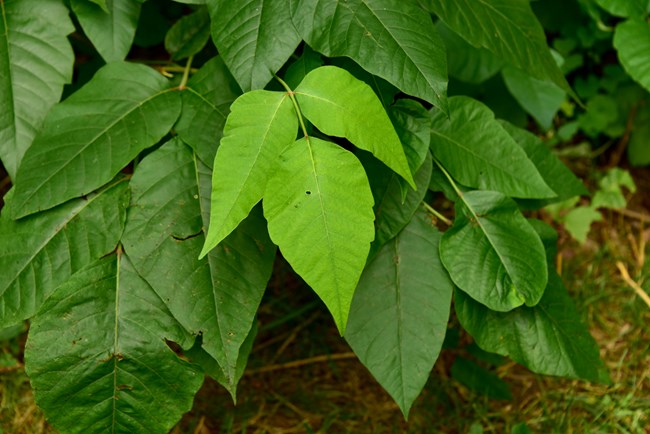
NPS Collection For people who enjoy nature, avoiding poison ivy is a priority. Nothing puts a damper on an outdoor experience like an itchy rash. Folk sayings remind us of this plant’s two famous characteristics: “leaves of three, let it be” and “if it’s hairy, be wary.” The challenge is that poison ivy looks different seasonally and throughout its lifecycle, and is easily confused with other common plants. Your reaction can change over time, so caution is best. Know Your EnemyPoison ivy grows as either a small shrub or a vine trailing along the ground or climbing on low plants, trees, and other surfaces. It is most commonly found in disturbed areas, woodland edges, pond and stream banks, and around buildings. Three pointed and glossy leaflets grow alternately off the stem and usually have irregular teeth. Leaves are reddish when they first emerge in spring; green during summer; and various shades of red or yellow in autumn. Vines can grow as thick as an arm and are covered with fine hairs that tightly grip the climbing surface. Poison ivy is an important food source for wildlife. Small bees and flies pollinate the greenish-white flowers in spring. Other insects feed on the leaves, and birds eat the clusters of whitish-yellow berries in fall and winter. You Got It!Reaction to poison ivy tends to be worse in the spring and early summer when leaves are tender. About 60-80% of people are sensitive to the urushiol oil present throughout the plant. Most people develop symptoms within a few hours or days. Symptoms start with severe itching of the skin, followed by redness and blistering that lasts about a week. In severe cases, large blisters and localized swelling occur. It only takes 10-15 minutes for the oil to penetrate and bind with skin, so quickly wash with soap and water (or a post-poison ivy contact solution) to minimize rash severity and prevent the spread of the oil to unaffected body parts. Topical steroid creams and calamine lotions can help dry the blisters. Severe rashes, especially those covering large or sensitive areas or accompanied by fever, should be examined by a physician. PreventionAvoid poison ivy by wearing a long-sleeve shirt and long pants. Apply a pre-contact solution (available at drug stores) to exposed skin. If you must handle the plant, wear impermeable gloves. Remove and immediately wash clothing, gloves, and footwear in detergent or soap. Park staff does limited spraying in some gathering places. Basic precautions will make time outdoors more enjoyable. |
Last updated: January 12, 2022
